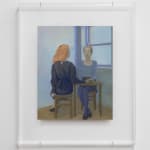-
Artworks
Natasha Walsh
Dear Dora ('La Conversation' Reimagined), 2022oil on copper30 x 24 cm / 47 x 40 x 3.5 cm (framed)Further images
Dear Dora, On a trip to the Tate Modern, in a happy accident, I happened upon a rich retrospective of your practice. I no longer see you in Picasso’s Weeping...Dear Dora,
On a trip to the Tate Modern, in a happy accident, I happened upon a rich retrospective of your practice. I no longer see you in Picasso’s Weeping Woman.
I can see instead why you gained so much respect as a surrealist photographer, long before you had ever met him and I would add my admiration to the rest.
The imaginative assembly of your images and the power of the female gaze within, always surprises me. In particular, I admire your pioneering experimental work in the dark room. With your technique ‘cliche verre’ you have managed to make drawings with the most elusive of materials, light. Enlivening the clean mechanical lens with human touch. This interest in pushing the boundaries of your medium resonated personally with my own experiments. In particular with copper which becomes a reactive support in my painting when not sealed from pigments by a gesso, as in the works of Rembrandt.
I made this particular copper painting for you, in response to your work ‘La conversation’. I was drawn to ‘La conversation’ not only because it was one of the few paintings in the Tate show, that captured the eye with its saturated use of red, but also because it was the one work where you addressed directly your relationship with Marie-Therese Walter. This interested me as it seemed everyone else had voiced their own strong opinions, in particular the man himself, your shared lover who cast his shadow over all. In ‘La conversation’, your gaze defines your own representation, taking it beyond Picasso's two dimensional characterisation. His control of the narrative where he presented Walter and yourself as two opposing caricatures, her softly rounded and yourself as cuttingly hard, was subverted in your painting. While you have depicted Walter in the light and yourself in the dark, both are painted with a similar brush. I found it interesting how the table functions as both a point of opposition as well as a point of connection, creating the possibility of a conversation. You leave a space for us at this table, by your side, so we can witness this encounter. Shoulders touching in this, the two figures seem more connected than disconnected, exploring your shared uncomfortable history and mistreatment at the hands of Picasso, who wished to wipe you out of his past and any independent legacy or future you might posses. Lit by the same harsh light bulb hanging from above, in a room that feels flat and claustrophobic, like a kind of interrogation chamber. I wondered if this represents the public scrutiny you both faced for the rest of your lives?
I thought it might be interesting to invert your painting, as you did in the dark room when you developed a photographic negative. In such a way the composition of the figures becomes a mirror image in my work. The light hanging overhead becomes a window. The flatness begins to become three dimensional. The colours cool and I take up the position of both figures, as I imagine myself in both of your positions and try to empathise with that shared conflict and shared history. Your figure is no longer in shadow in my painting, but illuminated by the light from the window.
After all you are no longer in anyones shadow.
Yours truly,
Natasha
1of 3
Art, events and ideas in your inbox.
We won't send you lots of emails. Promise.
* denotes required fields
We will process the personal data you have supplied in accordance with our privacy policy (available on request). You can unsubscribe or change your preferences at any time by clicking the link in our emails.











